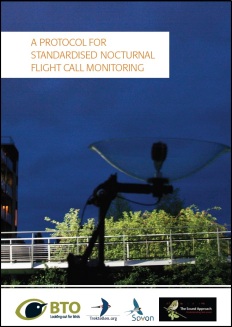Recording nocturnal flight calls is seeing a big surge in interest in Europe and all this effort scrutinising hours of audio has the potential to generate invaluable data on a large scale for understanding movement patterns of birds. Witness the amazing nocturnal movements of Common Scoters through inland England recorded in April-May 2018, the tantalising records of nocturnal Ortolan Buntings in southern England and continental Europe, and the amazing breadth and magnitude of nocturnal movements through Besh Barmag, Azerbaijan. There’s much to learn if the data can be collected and collated in a consistent manner.
 BTO, Sound Approach and Sovon have teamed up to produce a Protocol for Standardised Nocturnal Flight Call Monitoring (available here), and in parallel, significant improvements have been made to Trektellen for the submission and sharing of nocmig data. The protocol aims to highlight simple ways that recordings and the data extracted from them can be standardised whilst still allowing flexibility for local circumstances. It details aspects such as where and when to record, times of night to cover and which species to log. For example, we recommend that call logging starts no earlier than civil dusk and continues no later than civil dawn to exclude diurnal migrants. Ideally counts should be submitted in hourly blocks to allow future analyses of timing and weather, and all birds flying over should be logged whether they are considered to be migrants or local birds. These suggestions will be familiar to many seasoned recorders and should act as a guide for those just starting out.
BTO, Sound Approach and Sovon have teamed up to produce a Protocol for Standardised Nocturnal Flight Call Monitoring (available here), and in parallel, significant improvements have been made to Trektellen for the submission and sharing of nocmig data. The protocol aims to highlight simple ways that recordings and the data extracted from them can be standardised whilst still allowing flexibility for local circumstances. It details aspects such as where and when to record, times of night to cover and which species to log. For example, we recommend that call logging starts no earlier than civil dusk and continues no later than civil dawn to exclude diurnal migrants. Ideally counts should be submitted in hourly blocks to allow future analyses of timing and weather, and all birds flying over should be logged whether they are considered to be migrants or local birds. These suggestions will be familiar to many seasoned recorders and should act as a guide for those just starting out.
Trektellen has been collecting nocturnal flight call data for several years and with the latest modifications it is now possible to submit numbers of individuals and numbers of calls, which will be invaluable for species where estimating bird numbers is problematic. It is now easier to indicate which records relate to flying versus stationary birds and sound files uploaded to xeno-canto can now be embedded within Trektellen lists, which will be especially useful for sharing recordings of unusual or unverified records.

Alongside the advances being made by the Sound Approach and others in species identification, we hope this protocol promotes further interest in recording and submission of data from nocturnal flight call monitoring.
